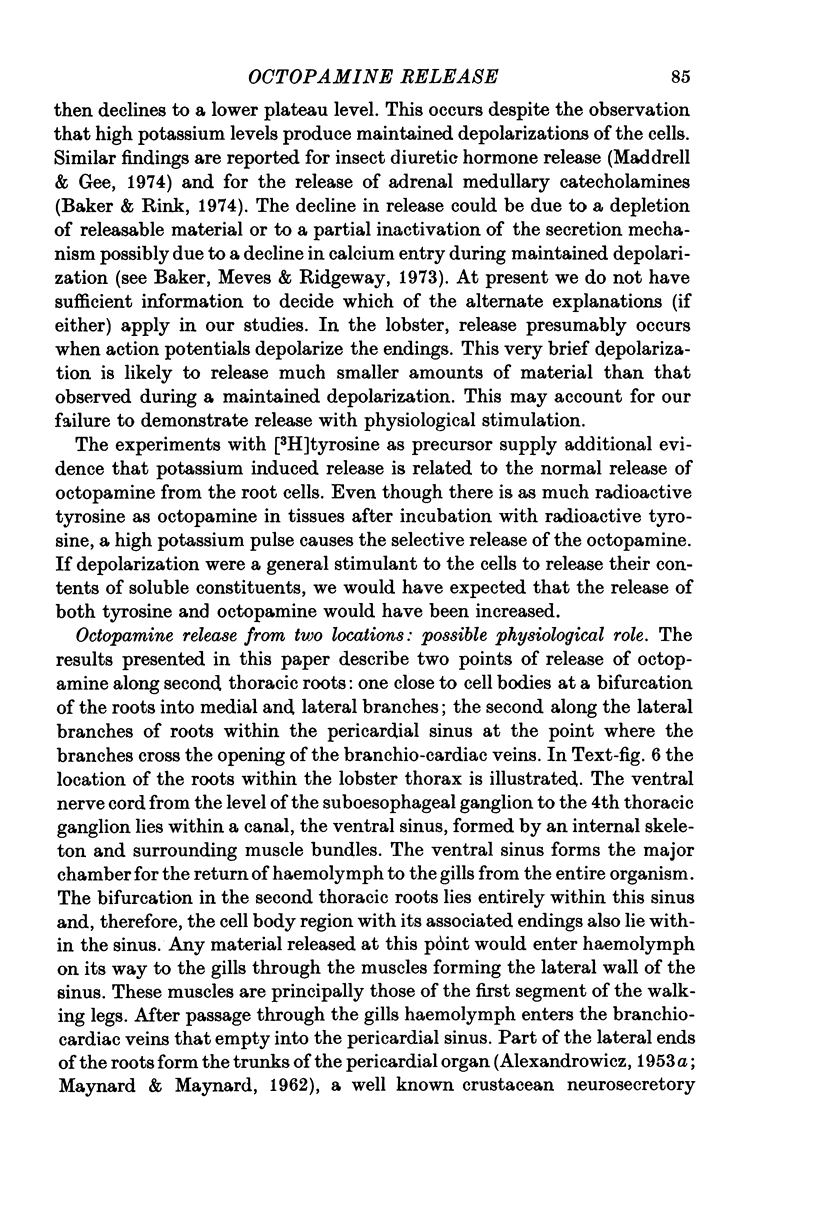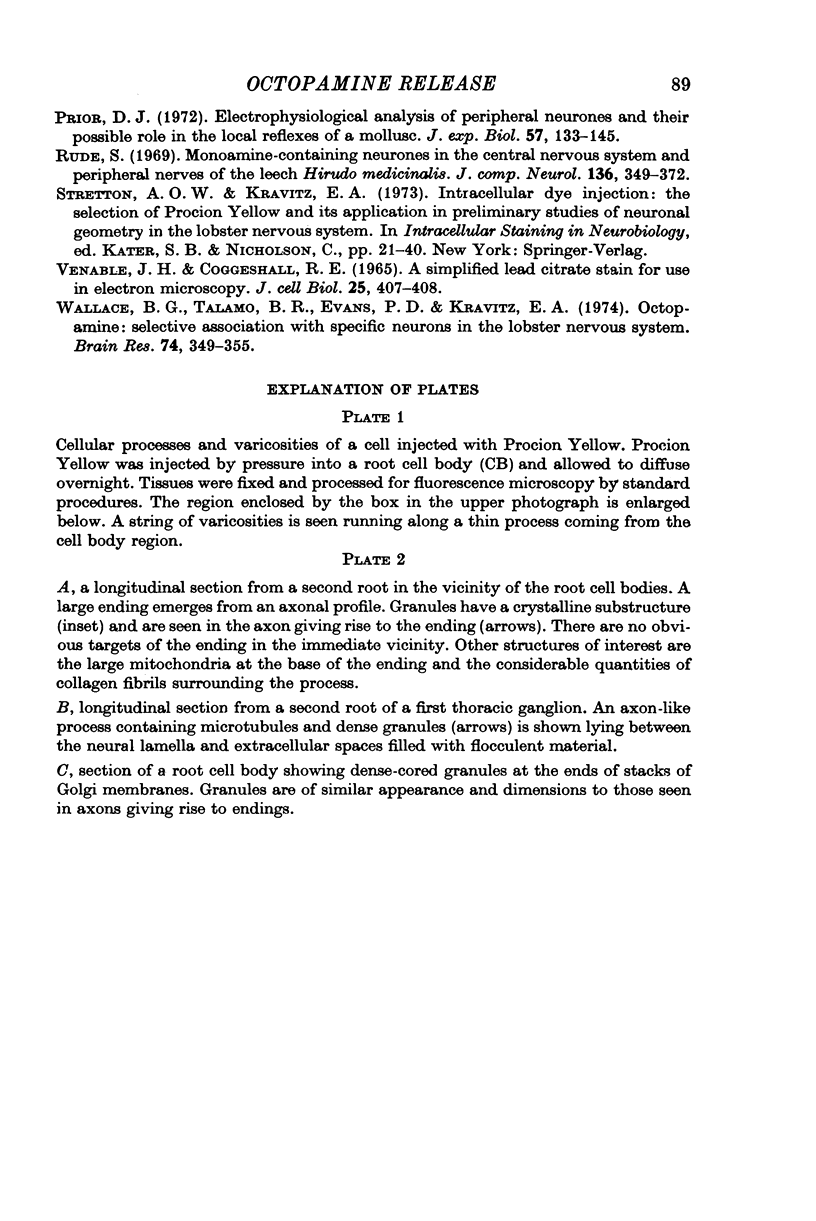Abstract
Nerve cells in the proximal regions of second thoracic roots in lobsters have been injected with the fluorescent dye Procion Yellow. Examination of the roots reveals an elaborate array of cell branches in a superficial layer of the root in the vicinity of the cell bodies. Large varicosities, up to 10 mum in diameter, are seen lined up along fine nerve branches. 2. In these same regions, electron microscopic examination shows the presence of large profiles filled with 0-1-0-2 mum dense cored granules, and having the appearance of nerve endings. These profiles probably correspond to the varicosities seen in the Procion Yellow injections. The dense cored granules within the endings have a crystalline substructure. All the endings are found within 7 mum of the surface of the root and no obvious physiological target tissue exists in their surroundings. Endings have not been traced directly to root cell bodies.However, granules of similar dimensions to those seen in endings are found in cell bodies, axon-hillock regions and numerous axonal profiles in the superficial root regions near cell bodies. The morphological studies suggest that the root neurones have the typical appearance of neurosecretory cells. 3. Octopamine pools in cell body regions of second thoracic roots can be isotopically labelled by incubation with either [3H]tyramine or [3H]-tyrosine. After labelling, pulsing with 100 mM potassium causes an increase in the rate of release of radioactive material. Upon return to normal media background rates of release are re-established. The enhanced efflux has the following properties: (a) repeated pulses of potassium release less radio-active material each time; (b) a prolonged potassium pulse produces first a peak of release, then a decline to a plateau, and the plateau level of release is maintained for the duration of the potassium pulse; (c) release is dependent on the presence of calcium ions in the bathing fluid and 40 mM cobalt prevents release; (d) release is selective for octopamine. With tyrosine as a precursor compound, as much radioactive tyrosine as octopamine is found in tissues after incubation, yet pulsing with potassium causes an enhanced efflux only of octopamine from preparations. 4. Release of octopamine also can be demonstrated from pericardial organs near the ends of lateral branches of the roots and the properties of the release are identical to those seen with cell body regions. 5. Physiological studies, in which root cells are antidromically activated while recording from cell bodies, suggest that the distal endings of at least some of the root cells are at the pericardial organs. 6. The results suggest that root cell neurones are neurosecretory cells capable of releasing octopamine at two points: one near cell bodies, the other at the pericardial organs near the distal ends of the roots...
Full text
PDF




















Images in this article
Selected References
These references are in PubMed. This may not be the complete list of references from this article.
- Baker P. F., Meves H., Ridgway E. B. Calcium entry in response to maintained depolarization of squid axons. J Physiol. 1973 Jun;231(3):527–548. doi: 10.1113/jphysiol.1973.sp010247. [DOI] [PMC free article] [PubMed] [Google Scholar]
- Baker P. F., Rink T. J. Proceedings: Transient release of catecholamines in response to maintained depolarization of bovine adrenal medulla. J Physiol. 1974 Sep;241(2):107P–109P. [PubMed] [Google Scholar]
- Belamarich F. A., Terwilliger R. C. Neurosecretion of invertebrates other than insects. I. The nature and localization of neurosecretory substances. Isolation and identification of cardio-excitor hormone from the pericardial organs of Cancer borealis. Am Zool. 1966 May;6(2):101–106. doi: 10.1093/icb/6.2.101. [DOI] [PubMed] [Google Scholar]
- Cooke I. M., Goldstone M. W. Fluorescence localization of monoamines in crab neurosecretory structures. J Exp Biol. 1970 Dec;53(3):651–668. doi: 10.1242/jeb.53.3.651. [DOI] [PubMed] [Google Scholar]
- DOUGLAS W. W., POISNER A. M. STIMULUS-SECRETION COUPLING IN A NEUROSECRETORY ORGAN: THE ROLE OF CALCIUM IN THE RELEASE OF VASOPRESSIN FROM THE NEUROHYPOPHYSIS. J Physiol. 1964 Jul;172:1–18. doi: 10.1113/jphysiol.1964.sp007399. [DOI] [PMC free article] [PubMed] [Google Scholar]
- Dreifuss J. J., Grau J. D., Nordmann J. J. Effects on the isolated neurohypophysis of agents which affect the membrane permeability to calcium. J Physiol. 1973 Jun;231(2):96P–98P. [PMC free article] [PubMed] [Google Scholar]
- Evans P. D., Kravitz E. A., Talamo B. R., Wallace B. G. The association of octopamine with specific neurones along lobster nerve trunks. J Physiol. 1976 Oct;262(1):51–70. doi: 10.1113/jphysiol.1976.sp011585. [DOI] [PMC free article] [PubMed] [Google Scholar]
- Evans P. D., Talamo B. R., Kravitz E. A. Octopamine neurons: morphology, release of octopamine and possible physiological role. Brain Res. 1975 Jun 13;90(2):340–347. doi: 10.1016/0006-8993(75)90317-0. [DOI] [PubMed] [Google Scholar]
- Hildebrand J. G., Barker D. L., Herbert E., Kravitz E. A. Screening for neurotransmitters: a rapid radiochemical procedure. J Neurobiol. 1971;2(3):231–246. doi: 10.1002/neu.480020305. [DOI] [PubMed] [Google Scholar]
- MAYNARD D. M., MAYNARD E. A. Thoracic neurosecretory structures in Brachyura. III. Microanatomy of peripheral structures. Gen Comp Endocrinol. 1962 Feb;2:12–28. doi: 10.1016/0016-6480(62)90024-2. [DOI] [PubMed] [Google Scholar]
- Maddrell S. H., Gee J. D. Potassium-induced release of the diuretic hormones of Rhodnius prolixus and Glossina austeni: Ca dependence, time course and localization of neurohaemal areas. J Exp Biol. 1974 Aug;61(1):155–171. doi: 10.1242/jeb.61.1.155. [DOI] [PubMed] [Google Scholar]
- Maynard D. M., Welsh J. H. Neurohormones of the pericardial organs of brachyuran Crustacea. J Physiol. 1959 Dec;149(2):215–227. doi: 10.1113/jphysiol.1959.sp006336. [DOI] [PMC free article] [PubMed] [Google Scholar]
- Normann T. C. Calcium-dependence of neurosecretion by exocytosis. J Exp Biol. 1974 Oct;61(2):401–409. doi: 10.1242/jeb.61.2.401. [DOI] [PubMed] [Google Scholar]
- Prior D. J. Electrophysiological analysis of peripheral neurones and their possible role in the local reflexes of a mollusc. J Exp Biol. 1972 Aug;57(1):133–145. doi: 10.1242/jeb.57.1.133. [DOI] [PubMed] [Google Scholar]
- VENABLE J. H., COGGESHALL R. A SIMPLIFIED LEAD CITRATE STAIN FOR USE IN ELECTRON MICROSCOPY. J Cell Biol. 1965 May;25:407–408. doi: 10.1083/jcb.25.2.407. [DOI] [PMC free article] [PubMed] [Google Scholar]
- Wallace B. G., Talamo B. R., Evans P. D., Kravitz E. A. Octopamine: selective association with specific neurons in the lobster nervous system. Brain Res. 1974 Jul 12;74(2):349–355. doi: 10.1016/0006-8993(74)90590-3. [DOI] [PubMed] [Google Scholar]






